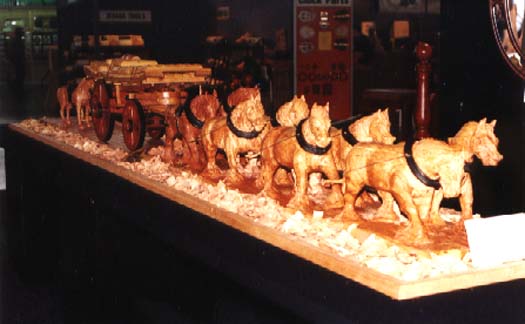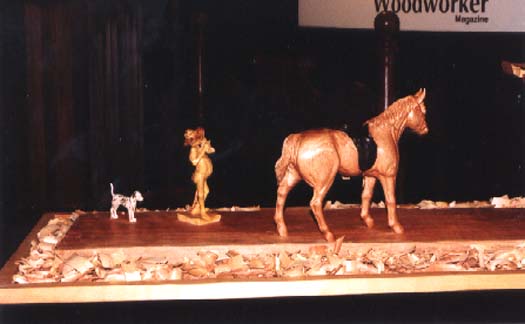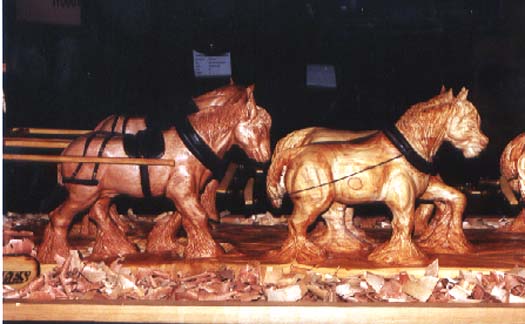
I began the Clydesdale sculpture in 1995. I had always wanted
to create a large carving - my biggest project yet - but didn't
until a tree was donated (Golden Cedar). The size of the tree
dictated the size of the sculpture. It was full of interesting
grain and many knots. I was hoping that the grain would help to
convey the energy and movement of the horses.
Research began through drawing. I wanted to make it an authentic
depiction of the actual wagon and horses from Yerranderie, a small
silver mining town in New South Wales that flourished in the early
part of this century. I studied old photographs from the Mining
Department, and visited Yerranderie where the remains of the mines
are, took photos and made several drawings. I talked to the owner
Val Lhuede and caretaker John Hopwood. I also visited the Oaks,
Camden and Yerranderie Museums. I found an authentic silver ore
hessian bag at the Oaks, and a great photo of a team of clydesdales
at the Camden Museums which helped as references for sizes and
proportions of the sculpture.
It was important to find out all the finer details for the bridles,
accessories and harnesses.


Before I began the actual carving I had to divide the log into
segments for each horse, with a chainsaw and Arbortech. It took
quite some time to remove the waste areas. I used a large fishtail
chisel (2 - 1 1/2 inches wide) and mallet.
I was also making notes to prepare to carve a "Teamster"
the man who is in charge of the horses, owns, feeds, and he drives
them. I interviewed several people, researchers (Ron Mills), historians,
and people who were part of that era, or family, or connected
with the mining, horses and life at that time.
I developed the character for the teamster from a series of sketches.
I wanted him to emulate the hard working laconic Australian bush
character. He has rough bearded face and worn clothes. He is drinking
from a hessian water bag.

I discovered that a stockhorse was used by the teamster. Clydesdales
could not be led by a reign. The team of horses is dominated by
one clydesdale known at the "leader;" the teamster whistles
and directs the leader and the rest of the team of horses follow.
I did encounter a major difficulty in that a large crack became
apparent. I had to change the stance of several of the horses
to avoid the cracks. I used tung oil, wax and shellac to prevent
any further cracking.
I wanted to include the knots in the timber because they do give
the work a unique colour and texture. Carving near a knot is challenging
and extremely difficult. I followed the grain as I carved to complement
the flowing movement of the horses.
I was searching for specialized timbers for the stockhorse. I
also needed to carve 2 two more clydesdales that I had lost from
the original log. Harry Clancy had to laminate pieces of Queensland
Maple to create three blocks big enough to carve the stockhorse
and the last two clydesdales.
I had problems carving underneath and in between each horse. I
used flat and back bent straight chisels to free the horses and
their legs. I also had to make a tool flat and curved at the end
to carve the horse's stomach.
I needed to interview locals of Yerranderie and owners of Clydesdales
at the Sydney Easter Shows, who had worked with the Clydesdales.
They were able to provide first hand accounts of the journey the
Clydesdales made pulling the wagon loaded with silver ore. The
terrain was quite difficult, the roads narrow and winding. Some
times the roads were washed away by inclement weather.
The wagon itself had to be purpose built. It was designed to carry
a massive load of approximately 8 to 20 tons depending on the
number of horses. The horses can pull one and half times their
own weight.

To construct the wagon took considerable planning, research and
many calculations. I was assisted by my brother Sandro de Aboitiz
who has an engineering background. He calculated the amount of
cargo each horse could carry including the weight of the wagon.
I was able to make the wagon close to scale following these considerations.
The final stage involved finer carving of the horses heads. I
wanted each horse to have individual expressions. I blackened
the saddle and collar with a blowtorch. These black areas needed
to be sanded back and waxed. The surrounding areas were covered
with shellac. The chains and bars, balanced correctly indicating
the pulling force required for the heavy load.


I decided to make the sculpture in two segments
so that it could be transported. Then joining the two segments
together - placing them on a large tray with the road and environment
in mind. ( Harry Clancy made the tray.)
Completing the sculpture in time for the 1999 Sydney Timber Show
was a major accomplishment. The whole project had taken about
four and half years to finish. Working on such a large scale project
posed equally huge problems for me to overcome. I see the work
now as an accurate representation of an important era in Australian
history. I wanted to show the majesty and power of the Clydesdales.
I was fascinated by their incredible strength and their endurance
on what must have been trecherous journey. I also admired those
men who led the horses. They must have had nerves of steel and
amazing skill in handling these animals.
I hope that the work captures the Australian spirit of survival.
In such a harsh and unforgiving environment these early settlers
were able to create a unique way of life.
Maricha Oxley is one
of Australia's most skilled wood carvers who centres her sculptures
around Australian icons. Her interest in the enormous variety
and beauty of Australian timbers has inspired her passion for
woodcarving. She has created carvings of Australian poet Henry
Lawson, famed racehorse Phar Lap and the outback legend, the swagman.
Detailed planning and research are essential to Maricha's creations. She begins with series of sketches based on photographs or direct observation of the subject. From these studies Maricha creates a three-dimensional clay model.
Maricha carefully chooses the timber for each
sculpture. She considers the rich colour, fine texture and quality
of the grain.
You are invited email Maricha Oxley at maricha@ozemail.com.au.